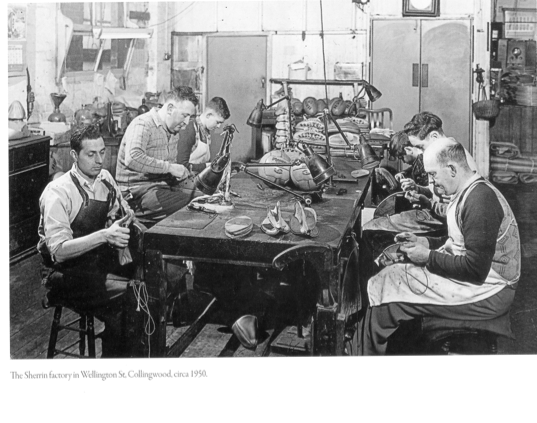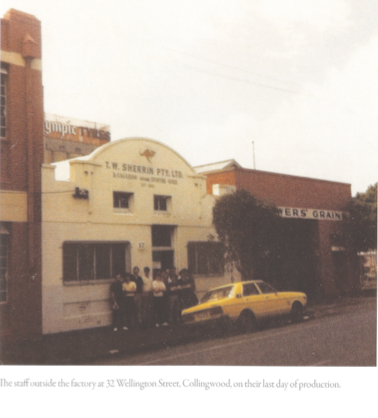Collingwood Notables Database
Thomas William Sherrin
1857-1912
Manufacturer, Collingwood Football Club Committee member
In football circles, Sherrin is a name to conjure with. Even non-football fans would probably recognise the distinctive name seen on so many footballs, but might not realise that the Sherrin name belonged to a family who lived and worked in Collingwood, and was deeply involved with the Collingwood Football Club. Thomas Sherrin was the founder of a business empire which not only manufactured a wide variety of sporting equipment, but also developed the distinctively-shaped ball which became the standard for Australian Football.
Thomas’s Irish parents were from Donegal and landed at Williamstown in February 1848. Robert, a carpenter, and his wife Rosina were living in Richmond when Thomas was born, but by the 1860s the numerous family was living in Cromwell Street Collingwood in a 3-roomed wooden cottage with a workshop. Robert died in 1883 leaving his widow the small cottage which was still mortgaged, and virtually no personal estate. Before this Tom had begun working as an apprentice saddler at 20 Wellington Street Collingwood with William Prytherch, who had established an early business in Collingwood and become a key figure in the Victorian protectionist movement. Manufacturing and repairing horse saddles, bridles and associated leather equipment for horse transport was a crucial business of the era.
In 1879 when Tom was 22 he began his own sporting goods business, apparently sharing premises with Prytherch. Tom remained close to the Prytherch family and was later made an executor of William’s will. At the Intercolonial Juvenile Industrial Exhibition of 1879-80 Thomas was awarded a first class certificate for his cricket balls, and his business continued to prosper. He mounted an impressive exhibition of cricket and other sports goods at the 1888 Centennial International Exhibition. In the 1890s he moved to a larger wooden shop a few doors to the north, at number 32. His ads in The Mercury in the mid 1890s list his many products:
Manufacturer of Cricket Balls, Baseballs, Footballs &c. Boxing Glove Maker to all the Leading Athletic Clubs in Australia. Patentee of the celebrated Punching Ball. Cricket and Baseballs Recovered equal to New.
According to family stories, Tom, with his expertise in working with leather, was often asked to repair the rugby balls which were then used for Australian football, and eventually realised that the Australian game needed a ball of its own. He noticed that the rugby ball was wearing heavily on the ends, so created a slight variation, rounder on the points, which meant it was still oval but easier to kick. As described on Boyle’s Football Photos website:
What is clear is that Sherrin’s rise as an important manufacturer of footballs occurred in the 1890s, and that his ball became the standard ball used in Victoria (probably for both Rugby and ‘Australian Rules’). The Sherrin ball was distinctively Australian in shape, and was to take over as the new standard ball, at least in Melbourne, for Australian Rules Football.
Tom had an abiding interest in many facets of sport. He was on the committee of the local Britannia Football Club; and when the Collingwood Football Club was formed in 1892 he was elected to that committee and remained on it for 20 years. He was awarded life membership in 1905, and was the Club's first No. 1 Ticket-holder. This commitment to the Collingwood Football Club was to continue through many generations of the Sherrin family, which was honoured in 1969 by the opening of the Sherrin grandstand at Victoria Park.
When Tom died in 1912 after a long illness, he owned the properties by then known as 32, 34, 36 and 38 Wellington Street. Numbers 36 and 38 were cottages which he let, while 32-34 were used as his shop and factory. Here he lived simply in one furnished room, although his personal assets were valued at several thousand pounds. With no children of his own, he left the business to his nephew John Sydney, usually known as Syd, who had started an apprenticeship with him in 1903. Two of Syd’s brothers also worked for their uncle Tom, and all lived nearby at 63 Hotham Street. In 1915 a major fire at the factory destroyed stock, but also the collection of sporting pictures. Syd opened temporary premises on the opposite side of Wellington Street while the factory was re-built. When Syd died in 1941 his son Tom took over; Syd’s widow Elsie also worked at the factory. This younger Tom Sherrin continued his great-uncle's service on the Committee of the Collingwood Football Club, where he served for three decades and notably as President from 1963-1974.
Tom sold the business to Spalding in 1963, but stayed on as manager of the Sherrin division in Wellington Street. It seems extraordinary that footballs were hand-stitched until the 1990s. The Collingwood factory closed in December 1982 and all Sherrin operations moved to Spalding’s Sunshine factory. The Russell Corporation later took over Spalding Australia.
Life Summary
| Birth Date | Birth Place |
|---|---|
| 1857 | Richmond |
| Home Street | Home City | Status of Building |
|---|---|---|
| 72 Cromwell Street | Collingwood | Demolished |
| 32-34 Wellington Street | Collingwood | Re-built |
| Work Street | Work City | Status of Building |
|---|---|---|
| 20 Wellington Street | Collingwood | Demolished |
| 32-34 Wellington Street | Collingwood | Re-built |
| Church | Lodge |
|---|---|
| Anglican |
| Death Date | Death Place | Cemetery |
|---|---|---|
| 19 November 1912 | Boroondara |
The Argus; The Age; The Mercury and Weekly Courier; Mornington Standard; Melbourne Punch; Leader; The Australasian; Launceston Examiner; Blainey, A game of our own; The Australian game of football; Sherrin, The family behind the football.
http://www.boylesfootballphotos.net.au/article39-The-Same-Game-A-Different-Ball




